Best Planet viewing time 2018
| Planet | Optimal date | Opposition |
|---|---|---|
| Mars | 21 Jul – 3 Aug | 27 Jul |
| Jupiter | 16 Apr – 4 Jun | 8 May |
| Saturn | 10 Jun – 16 Jul | 27 Jun |
| Uranus | 31 Aug – 11 Dec | 23 Oct |
| Neptune | 15 Jul – 30 Oct | 7 Sep |
Jupiter is easily visible now, but it'll be 1/3 bigger on its optimal dates. Mars is also visible now, but it is really small. It will be 4x bigger in July, in fact, at its brightest (i.e. closest) since 2003.
Inner planets:
- Mercury: 6 – 22 Mar ...
- Mercury (morning): ... 8 – 29 Dec
- Venus: 12 Mar – 17 Oct; 20 Sep (brightest)
- Venus (morning): 5 Nov – 31 Dec; 1 Dec (brightest)
The inner planets show up very often, but they are hard to catch in Singapore as they are low on the horizon and set soon after sunset.
127SLT first looks
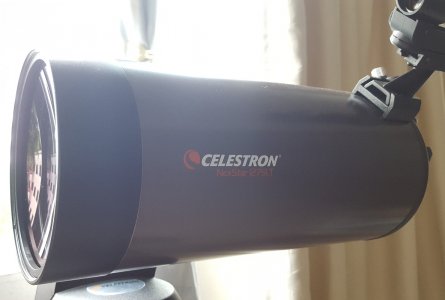
The Celstron NexStar 127SLT has a focal length of 1500mm and aperture of 127mm. It costs US$450 on Amazon. (It costs quite a bit more in Singapore!) It is suitable for a serious beginner, but it is also good enough that an amateur astronomer may never outgrow it.
It is of Maksutov-Cassegrain (Mak for short) design, hence it is very compact. The small size makes it very portable. The OTA (Optical Tube Assembly) weighs ~3.4 kg, with mount ~8 kg. It is pretty light as far as telescopes go.
It excels at planetary observations due to its long focal length, giving magnification of 200x to 300x. Mars at -3.0 apparent magnitude and Jupiter at -1.61 are easy targets.
It is also okay for brighter Deep Sky Objects (DSO), thanks to its 5" aperture. The bigger the aperture, the more light it collects.
It is not good for wide-field observation due to its narrow true field (~1.1 degrees), but very few DSOs are wider than 1 degrees. Well known exceptions are, Orion Nebula (M42), ~1.4 degrees, 4.0 apparent magnitude; Pleiades open star cluster (M45), nicknamed Seven Sisters, ~2 degrees, 1.6 apparent magnitude; and Andromeda galaxy (M31), ~3 degrees, 3.44 apparent magnitude. Also, you can always pan around. :lol:
It is also not good for faint object astrophotography due to its slow speed (f/11.8). It requires four times exposure time compared to a decently fast f/5.6 scope.
It uses 1.25" eyepieces. There is no option for 2" eyepieces — Maks generally have small baffle opening. This is not a limitation though. The usable eyepiece range from 6mm to 32mm, all available in 1.25" size. It comes with 9mm and 25mm eyepieces.
The star diagonal produces upright but laterally inverted image (right is left). This is norm.
As this scope targets beginners, it comes with a computerized motorized alt-azimuth mount, i.e. it is a GoTo telescope. There is no manual control. No power means no movement. :lol: The AZ mount is the main reason why this scope cannot do astrophotography — it causes star field rotation in long exposures. The tracking is also not accurate enough, although that may be worked around by stacking short exposures.
Out-of-box, the mount is not sturdy enough at high magnification, but it can be improved.
Practical usage issues you may have never heard of:
- Collimation: none needed (usual for Maks). Extremely beginner-friendly. :lol:
- Acclimation: not an issue in the tropics. Otherwise needed due to its large front glass, but still acceptably fast (30 mins?) due to its relatively small size.
- Dew formation: dew shield is needed for long observation (over 30 mins) due to its large front glass, as with all Maks.
Final word
A 5" Mak scope is at a sweetspot. It does what it does very well, passable on others, is light weight and at a very good price point.
It does most things well enough that it makes the upgrade path difficult. The next telescope has to be smaller/lighter or much bigger. Whatever it is, it will be more expensive!
Blu-rays update
To my surprise, Studio Ghibli shows are now released by GKIDS in the US.
Nausicaa is the color-corrected version and costs US$17.19. :lol: Although I prefer the original release (with the color-cast) and I don't want any duplicate, I can't resist it at this price. It saves me some time and effort doing my own processing. :-P
Argh, not long after I bought it, the price went down to US$12.99. :duh:
Even the low price cannot entice me to get Kiki's Delivery Service and Totoro. I used to like them, but they have very slow pacing. I'm serious when I say I only want to collect my favourite Studio Ghibli shows.
Recent blu-ray purchases:
- Cars (US$24.99)
- Ghost In The Shell 2017 (US$14.99)
- Guardians of the Galaxy (US$24.99) [not watched]
Cars went down to US$19.99 for a while. GitS 2017 is now US$9.99. This shows how unpopular it is. :-O GotG is now at US$19.99 after running out of early suckers. All in all, I paid US$15 extra!
Lesson: always wait a while for prices to go down.
I'm now waiting for Blade Runner 2049 (US$24.99). No way I'm paying this price! I believe it will come down in price soon as it is not very popular. :-P
I may buy Cars 3 (US$24.38) [not watched]. I doubt this will come down in price any time soon.
Maze Runner: The Death Cure was just released in theatres. By all accounts, it is a very generic rescue-mission action film. I have not watched any of the shows, but I watched some reviews and they changed the parts that I dislike about the second and third books, so they are better! :lol: I'll wait for the Maze Runner trilogy boxset, hopefully at a good price.
Jumanji: Welcome to the Jungle is also on the radar. I've not watched it, but it seems enjoyable.
A game of acquire
Big news in the board game industry: Asmodee just bought over all Mayfair Games IP. They bought Catan in 2016, that was like 70% of Mayfair Games (wild guess), and many people thought it was just a matter of time. That time is now.
(Some larger names that Asmodee has absorbed in the past years: Days of Wonder, Fantasy Flight Games, Z-Man Games.)
Not much will change in the short term, as both companies have MAP (Minimum Advertised Pricing). But Asmodee will have more bargaining power over online retailers now (i.e. either their way or the highway).
For a few months now, board games are no longer at 25 - 40% discount, but a mere 10% off. Asmodee also made clear of its strategy of trading volume for price. This is why counterfeiting scares them so much. But this is also why people turn to fake products. A board game, even a well-produced one like Ticket-to-Ride, does not feel like it is worth US$40. And many niche games are priced at US$50 - $60.
In another news, someone from Mayfair Games said they are working on an expansion to Nuns on the Runs, with a new board and co-op mode. It is due next year. I look forward to it. :-D
Time to run
With my latest acquisition Clue – The Great Museum Caper, I now have a whole slew of "chaser" games:
- Clue: TGMC
- Curse of the Mummy
- Fury of Dracula (2nd ed)
- Fury of Dracula (3rd ed)
- Ghost Chase
- Scotland Yard
Well, I just added one more, Nuns on the Run (2010) [US$31.72]. It did not make the cut last time because I thought it was too similar to the other chaser games that I had. But now I changed my mind. :lol:
Nuns on the Run is often described as Scotland Yard in reverse. All the players (except one) play the invisible "thieves" and try to "steal the valuables" while avoiding the visible "police".
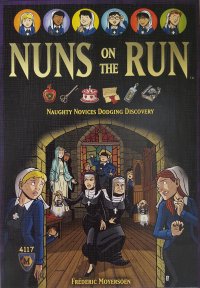
Under the cover of the night, the novices leave their cell to collect their secret wish item and return to their cell within 15 turns. But first, they have to collect a designated key to unlock the chest/cupboard that stores their wish item. That key (as well as any other keys) allows them to unlock doors. They can either stand still, sneak (1 - 2 spaces), walk (3 - 4 spaces) or run (up to 5 spaces). The faster they move, the more noise they make, allowing them to be heard further away. Each novice is also given a blessing card that gives a one-time power.
At the same time, the Abbess and the Prioress are on patrol. They start off by walking (3 - 4 spaces), but they can switch to running (5 - 6 spaces) midstream.
The guards are visible on the board and the novices are invisible, even to one another, except when they are spotted by the guards. The players keep track of their positions in secret. As the guards move one step at a time, the novices indicate if they are spotted (based on line-of-sight rules).
If a guard walks, the novices have to do a noise check after their own movement and after both guards move. If a novice is too noisy (basically, within x spaces of the guard), the guard is alerted to her presence. This is indicated by placing a noise token next to the guard, in the direction of the shortest path to the novice.
The guards may only divert from their set paths if they hear noises or outright see a novice, unless they have a special blessing card to let them do otherwise. There are many times the guard player knows a novice is nearby, but he is unable to pursue her because she is silent. :lol: Once the disturbance ends, the guards resume their set patrol.
If a novice is caught, she is supposed to return to her cell. But she only has to move in the direction of her cell until she is out-of-sight, then she is free to resume her quest. :lol: She loses her wish item if she has it, but not her key. The guards may not follow nor catch her again during this time.
The guard player also win if he catches as many novices as there are players. If there are three novices, he has to catch them four times.
This is a rather light-hearted cat-n-mouse game. The odds are actually in favour of the novices; it is easier for a novice to win than the guard player. The question is, are you the fastest novice?
More eyepieces
Previously, I said there are two ways to see as much of the sky as possible: 32mm 52° and 24mm 68°. And I also list the maximum apparent FOVs constrained by the 1.25" barrel size:
- 13mm: 100 degrees
- 18mm: 82 degrees
- 24mm: 70 degrees
- 32mm: 52 degrees
- 40mm: 43 degrees
These give ~1.1° true field. Since we prefer the 24mm to 32mm, why not go all the way to 13mm? Same true field but bigger view. There are in fact such wide eyepieces:
| F Len | Deg | Mag* | True field* | Wt | Eye relief | Price | |
|---|---|---|---|---|---|---|---|
| 32mm | 52° | 46.9x | 1.11° | Celestron Omni | 130g? | 22mm | US$38 |
| 24mm | 68° | 62.5x | 1.09° | Explore Scientific 68° 24mm | 329g | 18.4mm | US$140 |
| 16mm | 82° | 93.8x | 0.87° | Tele Vue Nagler 16mm WA | 202g | 10mm | US$339 |
| 13mm | 100° | 115.4x | 0.87° | Tele Vue Ethos 13mm UWA | 590g | 15mm | US$609 |
*With 1500mm focal length.
At higher powers, only the best eyepieces will do, and they quickly get heavy and expensive. The Ethos 13mm eyepiece costs more than the scope! But even if you can afford it, do you want it?
Here is one reason why not: doubling magnification reduces brightness by four times. So a 13mm eyepiece is roughly a quarter as bright as a 24mm. You need every bit of light for Extended Objects (i.e. nebulas and galaxies) as they are pretty dim. Stars are not affected as they are point objects.
Extreme high power
After 24mm and 11mm eyepieces, the next range is 7 - 9 mm for extreme magnification for planetary observations.
Unfortunately, Explore Scientific fails us here. They have a 8.8mm eyepiece, which is too "short" (170x) and close to 11mm. Their next eyepiece is 6.7mm (223.9x), which falls into the "are you feeling lucky" category.
If only there is a 7.5mm - 8mm eyepiece... Yes, there is, the Tele Vue Ethos 8mm eyepiece, giving 187.5x magnification. It costs US$575, which is a lot of money for something that will be used rarely, though.
| F Len | Deg | Mag* | True field* | Exit pupil* | Wt | Eye relief | Price | |
|---|---|---|---|---|---|---|---|---|
| 11mm | 82° | 136.4x | 0.60° | 0.93mm | Explore Scientific 82° 11mm | 279g | 15.6mm | US$160 |
| 8.8mm | 82° | 170.5x | 0.48° | 0.75mm | Explore Scientific 82° 8.8mm | 255g | 15.6mm | US$160 |
| 8mm | 100° | 187.5x | 0.53° | 0.67mm | Tele Vue Ethos 8mm UWA | 430.9g | 15mm | US$575 |
| 6.7mm | 82° | 223.9x | 0.37° | 0.57mm | Explore Scientific 82° 6.7mm | 228g | 15.7mm | US$160 |
*On a 127mm f/11.8 scope.
Maximum magnification, revisited
Another rule of thumb for maximum magnification is 50 * aperture in inch. This gives 250x for 5" aperture.
However, 3 - 4" aperture can use 70/aperture-inch as they are less affected by air turbulence. 5" aperture can use 60/aperture-inch, giving maximum magnification of 300x. Under this guideline, 224x is well within the limit.
Upgrading eyepieces
The Celstron NexStar 127SLT has a
focal length of 1500 mm, aperture of 127mm (1500 / 127 = focal ratio f/11.8)
and uses 1.25" eyepieces. It comes with two eyepieces, a 9mm (1500 / 9 =
166.7x) and a 25mm (60x), both 52° FOV.
Update: the 25mm eyepiece is modified Kellner design with 52° FOV. Celestron calls it Super Modified Achromat (SMA). The 9mm eyepiece is a standard Kellner design with ~45° FOV.
The first impression is that the 9mm is too shaky (close to the limit of this scope) and while the 25mm is nice (just right for the Moon!), the viewing window is too small — it is like looking through a porthole.
A few things to look for in an eyepiece:
- Focal length
- Field-of-view
- Eye relief
- Price
The scope imposes three limits. First, the maximum usable magnification is 254x (rule of thumb: 2x aperture in mm). However, the atmosphere further limits it between 150x (1500 / 150 = 10mm) on normal days and 250x (6mm) on good days. This is true for all telescopes.
The second limit is maximum true FOV (often shortened to true field) — the area of the sky seen through the scope. It is ~1.1 degrees (field stop 27.5 mm / focal length 1500 mm * 57.3 degrees/radian = 1.05 degrees).
Third, the maximum (apparent) FOV is constrained by the 1.25" barrel size:
- 13mm: 100 degrees
- 18mm: 82 degrees
- 24mm: 70 degrees
- 32mm: 52 degrees
- 40mm: 43 degrees
(Apparent) FOV determines how wide the view looks. The bigger the FOV, the bigger the viewing window. As mentioned earlier, 52° is like looking through a porthole. 68° is nice, 82° is wide (immersive) and 100° is way too wide (too big, heavy and expensive).
For a given eyepiece, the true field is FOV divided by magnification, capped by the maximum true field.
For this scope, the usable eyepiece focal length ranges from 5.9mm (254x, limited by max magnification) to 32mm (46.9x, limited by max true field).
There are two ways to see as much of the sky as possible: 32mm 52° and 24mm 68°.
32mm covers the max area of the sky (52 / 46.9 = 1.11°), but 52° FOV means the viewing area is very narrow. 24mm 68° is the sweetspot for 1.25" eyepiece. It covers 1.09° true field (almost same area), the image looks bigger due to higher magnification (62.5x vs 46.9x) and gives a larger viewing area (due to its 68° FOV).
24mm 68° is definitely the better choice. The only issue is cost. One of the better yet still affordable eyepiece is Explore Scientific 68° 24mm eyepiece (329g) with 18.4mm eye relief. RRP US$140, on sale for US$112.
Getting this eyepiece will render the bundled 25mm eyepiece useless. There is also no need to get a (cheap) 32mm 52° eyepiece.
After settling the wide field part, we now look at high power part. We want the second eyepiece to be around 11 - 14mm (136x to 107x). Anything below 11mm is hard to use (sturdy tripod, good seeing).
In this range, I prefer the 11mm for its higher power. The question is, 68° or 82°? If cost is not a matter, definitely 82°. :lol: A good eyepiece is the Explore Scientific 82° 11mm eyepiece (279g) with 15mm eye relief, giving true field of 0.60°. This is big enough to fit the entire Moon into view! RRP US$160, on sale for US$128.
This replaces the bundled 9mm eyepiece for most part.
If we get the 11mm eyepiece, we will probably skip both 14mm and 16mm (68°) as they are too close. The ES 82° 14mm (US$160, 256g) has a true field of 0.77° with 15.6mm eye relief, so it is better than the ES 68° 16mm (US$140, 158g) that gives 0.73° true field. The latter also has very little eye relief at 11.9mm.
The only downside to using a pair of 24mm and 11mm is that they don't barlow (i.e. 2x extender) well. They give 12mm (too close to 11mm) and 5.5mm (exceeding resolving power). They work well with 1.5x extender though, giving 16mm and 7.3mm.
Cost
Cost is definitely an issue. The two eyepieces cost US$300 at RRP, which is 66% the price of the scope. :sweat: But think of the scope as the camera and the eyepiece as the lens. In film photography, the lens is always more expensive than the camera. :-O With digital sensors and post-processing, the lens is not as important anymore.
What about exit pupil?
Exit pupil is the diameter of light cone that exits from the eyepiece. Human eyes accept 0.7mm to 5 - 7mm, depending on age. Anything wider is lost. The optimal range is 1mm to 4mm.
Exit pupil can be calculated by telescope aperture divided by magnification.
For this scope, the exit pupil ranges from 0.5mm (127 / 254) for 5.9mm eyepiece to 2.71mm (127 / 46.9) for 32mm eyepiece, so it is never an issue.
Red and blue Moon
Just before the Moon enters full eclipse:
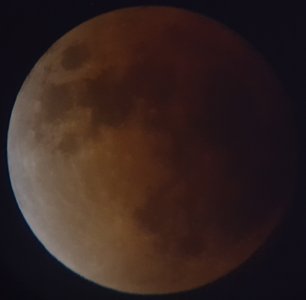
Samsung S6 handheld through a Celstron NexStar 127SLT at 60x magnification (focal length of 1500mm, focal ratio of f/11.8, 25mm 52° eyepiece).
The next blue Moon is on 31/3/2018. (Blue = a second full Moon in the same month.)
The next red (blood) Moon is on 27/7/2018.
The next Supermoon is on 21/1/2019.
The next super blue blood Moon is on 31/12/2028. The last one was in 1866!
Any clue?
Clue Master Detective is the 1988 US deluxe makeover of Clue.
It has never been reprinted. Until now. A B&N exclusive by Winning Moves, just in time for its 30th anniversary (though not marked as such) and costs just US$30. It is not an exact replica, though close.
If you like Clue, now is your chance to get the long OOP Clue Master Detective, which now costs US$50 - $200 used. I forgot how much I paid for it a decade ago. I got one of the "cheaper" ones, so my copy was not that pristine. The contents were okay, but the box had seen better days. Sadly, it got moldy a few years later under my neglectful care. :cry:
Will I get it? No. The original is good enough. :-D
Kill Doctor Lucky (1996)
Mention Clue and Kill Doctor Lucky is often brought up as a related game. Except it is not; it does not have any deductive elements at all. Instead of solving a murder case, the guests are trying to kill their host in a mansion. It got a well-done "19.5" anniversary deluxe release in 2016. But no, I still won't get this game.
Mystery of the Abbey (1995)
Mystery of the Abbey is often mentioned as a gamer's Clue. It looks that way, except that passing the suspect cards around the table ruins the deductive aspect totally. To retain that, everyone has to distinguish between has, seen and eliminated (which can be unreliable). The gameplay is fragile because the slightest tracking mistake will cause deduction to fall like a house of cards.
So no, I'm not interested in this game until it can be played deductively.
According to an old Tom Vassel review of the game, Mystery of the Abbey is the game that puts Days of Wonder on the map. DoW released it in 2003 in typical DoW style: high-quality, big box (then) and expensive. 2003 is also the year DoW released TtR, their runaway cashcow, so they would be famous anyway.
Mystery of the Abbey was reprinted in 2012.
Mystery Express (2010)
Another who-did-it deductive game by DoW. It is more deductive, sometimes described as MotA done right, although there is a very annoying memory part.
I'm not interested in this game. The deductive part is not strong enough to attract me. I've had enough of deductive games. :lol:
Counterfeit board games, huh?
Apparently counterfeit board games are now a thing. It has always existed in China, but the better made-ones — that are passable for the original at first glance — are starting to take off in the US. They cost around 50 - 60% of the original.
Example: 7 Wonders is US$40 (MSRP US$50). It used to be available for US$32 before MAP (Minimum Advertised Price) took effect in mid-2017. The counterfeit costs ~US$23.
The list includes:
- 7 Wonders
- Catan
- Dominion
- Pandemic Legacy: Season 1
- Ticket-to-Ride: Europe
Basically, high volume games.
Due to the counterfeits' relative high quality (at first glance), some people suspect they are "third-shifts", i.e. they come from the same factory that produces the genuine parts. However, that is not the case. Rather, they are reproduced from the actual products. The material is different, finishing is different, printing is misaligned, there is scanning artifacts, and color reproduction is slightly worse (either faded or too contrasty).
Euro-games are a niche. Even one of the most successful games, Ticket-to-Ride, sell only 4+ million copies in a decade. Counterfeit would be the last thing I expect.
Asmodee estimates that counterfeit sales have overtaken the original in the US! This is incredible because people started noticing it only in mid-2017. It is a huge concern for Asmodee because, oops, there goes their cash cow!
Board games have two things going for them. First, they have really low production costs. They are mostly cardboard, printing and plastic pieces. Card-based games are most vulnerable. So are text-free designs — a publisher's favouite due to ease of localization.
Second, they are marked up quite heavily. A rule-of-thumb is that production costs just 20% of MSRP. But the publisher does not get the full remainder. Suppose the distributor gets 20%, the retailer another 20%, and with 20% discount (who pays MSRP?), the publisher gets just 20% of the pie.
Suppose you already have the tools to produce board games, it takes you just 10 - 15% of MSRP to produce it. After all, you have to make a profit from 20% of MSRP.
This is the counterfeiters' cost. There is no way a publisher can compete. No way, that is, given their traditional structure. They have to be very lean in operations and cut the layers between them and the consumers. They also have to price their games at realistic levels. When there is a huge disparity between production and selling price, it creates an opportunity for counterfeiters to fill the gap (from production cost to 50% MSRP). This is true for every product.
Some ideas to counter counterfeits:
- Add some hard-to-manufacture components
- Add some extra content (redeem via mail)
- Add online game (with download code)
- Add security hologram sticker
None of these are foolproof. They are only obstacles to increase the difficulty.
Board game lean years
I bought only one game in 2017. How about 2016? It turned out I only bought two expansions for myself:
- 7 Wonders Cities (2012) [US$20.99]
- Race for The Galaxy: Xeno Invasion Board Game (2015) [US$17.07]
Games on my radar:
- Alien Frontiers (2010) [MSRP US$60]
- Dice Town (2009, 2017) [MSRP US$44.99]
- Jamaica (2007) [MSRP US$59.99]
- Kingsburg (2007, 2017) [MSRP US$59.99]
- Puerto Rico (2002) [MSRP US$44.95]
- Terraforming Mars (2016) [MSRP US$69.95]
I've not gotten them for one reason or another. Some have come out with a new edition in the mean time! :-O
- Alien Frontiers: worker placement, too much like Kingsburg
- Dice Town: on the short list since 2015
- Jamaica: looks nice, has potential, but is a race game, which I don't like
- Kingsburg: on the short list since 2015; worker placement
- Puetro Rico: waiting for new edition
- Terraforming Mars: looks nice, has potential, but is pretty expensive
As I mentioned before, my criteria is now very high. Perhaps I should prune my existing collection to make room — I have some duplicates and expansions that I will never use...
Board game catch-up 2018
Ticket To Ride: Nordic Countries (2008) [US$37.13]

TtR: Nordic Countries is the only game I got for myself in 2017. It is a standalone game for 2-3 players, the train on the cards are covered with snow, and comes with purple and white trains.
I often get the board game itch around December, and because this is winter-themed, it costs the most at that time (~US$45). And it is often out-of-stock in non-winter seasons due to low-print and low-demand. So I've skipped it for a couple of years.
My preferred TtR experience is still the USA base map with the original rules. TtR is a gateway game; keep it simple. I did not get any of the later expansions:
- The Heart of Africa (2012)
- Nederland (2013)
- United Kingdom & Pennsylvania (2015)
- France & Old West (2017)
I'm done with TtR. The only thing I want is to pimp the trains. :lol:
Clue – The Great Museum Caper (1991) [US$59.50]
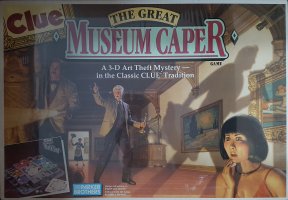
I bought all the Clue variants that I wanted a decade ago, except for this one. It was too expensive. All of them are OOP, but this one commands a premium due to its scarcity and/or better gameplay.
Fast forward a decade. It is still not reprinted (since 1991!) and one of the designers posted on BGG recently that they shelved plans to do so since their artist passed away last year. Oh well.
I saw a used copy on Amazon that did not break the bank. More importantly, it is fulfilled by Amazon, which means cheaper International shipping! Ships to Singapore for just US$12.10 (after splitting with Scotland Yard).
Listed as collectible, very good. Actual condition: to be
updated.
First look
Box is pretty large and is shrinkwrapped! :-O It is not new old stock (NOS), though. The box is a bit worn and has a small torn at the back. :cry: I'm not a mint box collector, so it is not a big deal. Contents are pretty new.
Ordered on 6/1, shipped on 7/1, received on 15/1.
Scotland Yard: A Compelling Detective Game (1991) [US$29.99]

I have the 2004 regular version. It works, except I've always found the board to be drab. The earlier ones were brighter. Guess what, Ravensburger reprinted it in 2013 and it came with the bright board! (I just found out about it.)
So, get the 2013 version? Well, the gameplay is exactly the same — the rules are streamlined for modern audiences, but you can always use the old ones. Also, I don't like the cover. I prefer the old cartoony one. :lol:
I can't justify buying a copy just for the new board, but I can make an exception for an older version for nostalgia... So, that's what I did. Buy a used copy from Amazon. It is fulfilled by Amazon, hence it costs only US$12.10 to ship to Singapore (after splitting with Clue – TGMC).
I don't know if I bought the 1983, 1991 or 1994 version. They have the same box cover.
Listed as collectible, very good. Actual condition: to be
updated.
First look
I got the 1991 edition. The box is slightly smaller than expected. The box is in fair condition; it is chafed and the edges are lightly crushed. I would rate it as heavy shelfwear. Contents are like-new.
(If the box is good, the seller will rate it as like new. Otherwise, he can only rate it as very good. There is a big price jump between the two.)
Ordered on 6/1, shipped on 11/1, received on 25/1. Amazon did not put any bubble-wrap at all, so the box was moving freely in the parcel.
Avalon Hill Acquire (1999) [EUR 49.99]
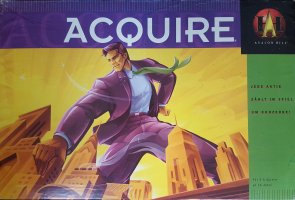
Acquire is one of the classics that age has caught up with since the 90s — it was released in 1964! It does not have shiny bits and the game looks boring/complicated.
The 2008 reprint was a cost-down version using cardboard components. The latest 2016 reprint took cues from the 1999 version: plastic board, tiles and 3D buildings. It is mostly okay, except the board is now 10x10 instead of 9x12 to streamline the game. And that changes everything; I want the original Acquire.
The 1999 Avalon Hill version is still the holy grail where English versions go. Due to that, it is very expensive. The cheapest used copy costs US$140+ on Amazon.
Tried my luck on Amazon.de. It is surprisingly "affordable", probably because it is the German edition.
Shipping costs EUR 14.00.
Listed as used, good. Actual condition: to be updated.
I have the 1993 Schmidt Spiele German edition. It was one of my holy grail a decade ago. But it is unwieldy to bring out. Interestingly, it can be had for cheap on Amazon.de — cheaper than this version. :-O
There is no definitive version of Acquire yet. The problem is that the tiles are very plain. Aesthetics is a big part of the experience nowadays. When the tiles form the hotel, they should take the color of the hotel chain. That would make it very pretty, and the game might keep its appeal to the modern crowd.
First look
It is the German edition. Box is a bit worn, but contents are like-new.
Ordered on 30/12, shipped on 2/1, received on 11/1. Parcel is recycled box.
Hans Im Glück Modern Art (1992) [EUR 14.90]

Modern Art is another classic that is more famous than it is popular. It is ugly and the gameplay is a bit abstract. It does not appeal to modern audiences.
The English version was first printed in 1996. I have the ultra-cheap looking 2004 version (though priced normally) and have long looked forward to a better reprint.
It was finally reprinted last year, but the art was changed. I prefer the original art (it is ugly as hell, but that is intentional), so why not go back to the original German edition? It is easily found on Amazon.de.
Shipping costs EUR 20.48.
Listed as used, good. Actual condition: to be updated.
I already have a near mint copy of this version. It was one of my holy grail a decade ago. I buy it again so that I can play with it. :lol:
I don't know if I bought the 1992 or 1993 version, probably the latter. Many Amazon sellers add their items to an existing product listing. These two versions are the same except for the box cover.
First look
I got the 1992 edition. My old one was also the 1992 edition. It looks like the 1993 edition (SdJ nomination and car cover) is more rare?
The box is okay, except for the lightly-crushed edges and a small torn at the back. Contents are like-new. Given my poor humid storage condition, this copy may be in better condition than my older one. :lol:
Ordered on 30/12, shipped on 1/1, received on 12/1. Parcel is thin cardboard, offering almost zero protection.
Processor armageddon
On the second day of the new year, news broke that an urgent fix will be applied to the Linux kernel. Basically, the kernel will unmap all kernel pages before it returns to user space. The fix is called Kernel Page Table Isolation (KPTI). This has a huge performance hit, anywhere from 5% to 50+%! Average slowdown is reported to be 30%. Microsoft and Apple are also preparing out-of-band fixes to their OS.
Why is this necessary? Kernel pages should already be inaccessible in user space. Or are they?
An AMD engineer was the first to give the details:
In other words, Intel CPUs can be tricked to read any mapped memory via speculative execution. This is huge, because it basically renders any supposed privilege levels useless. It makes a joke of virtualization.
Cloud computing, where strangers share the same physical CPU? They can steal your private keys. Oops. Surfing the net with JavaScript enabled? It can sniff for your password. Oops. It is that bad.
In the next few days, this exploit is named Meltdown. This affects Intel processors only. It is not known if it affects all Intel processors since 1995 (since out-of-order execution is introduced), or only "recent" ones (e.g. in the past decade) where speculative execution was turned up to eleven.
In typical Intel fashion, it tries to downplay the issue:
This is true, but the ability to read private keys and passwords is already most damaging among damages.
And conflate it with another issue:
At the same time, another more general attack called Spectre is described. This targets every modern CPU that uses caching and does speculative execution. This affects all Intel, AMD and many ARM processors. This attack is very fundamental and is harder to defend against, but it is also very slow because it uses timing side-effects to infer the actual data. Meltdown is a pure bug. That impenetrable door that you thought you had? It's unlocked.
What I find amusing is that the Raspberry Pi founder came out to say the Pis is not affected by either exploits. The key reason is that the ARM CPUs they use do not support speculative execution. That is why they are so slow, dude! :lol:
2017 has not been a good year for Intel. This is their second major flaw of the year. Earlier last year, the Intel Management Engine (IME) was revealed to be susceptible to hacking. That was already a huge news because it was an autonomous subsystem that was always running and was present on all Intel processor chipsets since 2008. You can be hacked without knowing it!